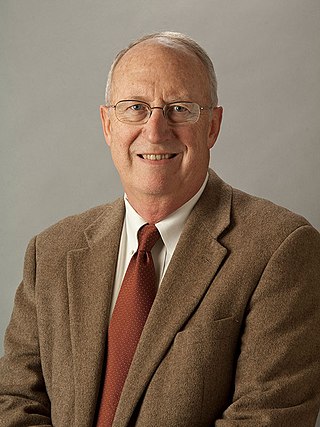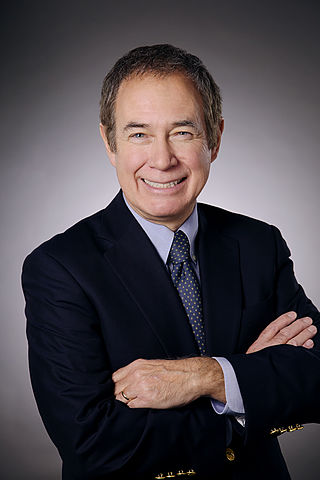
In physics, polaritons are quasiparticles resulting from strong coupling of electromagnetic waves with an electric or magnetic dipole-carrying excitation. They are an expression of the common quantum phenomenon known as level repulsion, also known as the avoided crossing principle. Polaritons describe the crossing of the dispersion of light with any interacting resonance. To this extent polaritons can also be thought of as the new normal modes of a given material or structure arising from the strong coupling of the bare modes, which are the photon and the dipolar oscillation. The polariton is a bosonic quasiparticle, and should not be confused with the polaron, which is an electron plus an attached phonon cloud.

Ellipsometry is an optical technique for investigating the dielectric properties of thin films. Ellipsometry measures the change of polarization upon reflection or transmission and compares it to a model.
Polaritonics is an intermediate regime between photonics and sub-microwave electronics. In this regime, signals are carried by an admixture of electromagnetic and lattice vibrational waves known as phonon-polaritons, rather than currents or photons. Since phonon-polaritons propagate with frequencies in the range of hundreds of gigahertz to several terahertz, polaritonics bridges the gap between electronics and photonics. A compelling motivation for polaritonics is the demand for high speed signal processing and linear and nonlinear terahertz spectroscopy. Polaritonics has distinct advantages over electronics, photonics, and traditional terahertz spectroscopy in that it offers the potential for a fully integrated platform that supports terahertz wave generation, guidance, manipulation, and readout in a single patterned material.
Phaedon Avouris is a Greek chemical physicist and materials scientist. He is an IBM Fellow and was formerly the group leader for Nanometer Scale Science and Technology at the Thomas J. Watson Research Center in Yorktown Heights, New York.
The College of Arts and Sciences (CAS) is the liberal arts and sciences college at the University of Nebraska–Lincoln (NU) in Lincoln, Nebraska. CAS was established in 1869, the same year the University of Nebraska was founded, and is the largest of NU's nine colleges. Mark Button has served as dean of the college since 2019.
Xi-Cheng Zhang is a Chinese-born American physicist, currently serving as the Parker Givens Chair of Optics at the University of Rochester, and the director of the Institute of Optics. He is also the Chairman of the Board and President of Zomega Terahertz Corporation.
David Erik Aspnes is an American physicist and a member of the National Academy of Sciences (1998). Aspnes developed fundamental theories of the linear and nonlinear optical properties of materials and thin films, and the technology of spectroscopic ellipsometry (SE). SE is a metrology that is indispensable in the manufacture of integrated circuits.
Richard C. Powell is an American professor emeritus of physics and vice president emeritus of the University of Arizona (UA), whose career focused on research in materials science and laser optics. He served as president of the Optical Society of America in 2000.
Andrea Alù is an Italian American scientist and engineer, currently Einstein Professor of Physics at The City University of New York Graduate Center. He is known for his contributions to the fields of optics, photonics, plasmonics, and acoustics, most notably in the context of metamaterials and metasurfaces. He has co-authored over 650 journal papers and 35 book chapters, and he holds 11 U.S. patents.

John Arthur Woollam is an American educator, research physicist, electrical engineer, and George Holmes Distinguished Professor at the University of Nebraska–Lincoln in Lincoln, Nebraska. He is also a successful entrepreneur who in 1987 founded the J.A. Woollam Company, an ellipsometry company based in Lincoln, Nebraska, and a world leader in the research, development, and commercialization of ellipsometry instruments. Woollam is also a known as a philanthropist and nature conservationist.

Paul R. Prucnal is an American electrical engineer. He is a professor of electrical engineering at Princeton University. He is best known for his seminal work in Neuromorphic Photonics, optical code division multiple access (OCDMA) and the invention of the terahertz optical asymmetric demultiplexor (TOAD). He is currently a fellow of IEEE for contributions to photonic switching and fiber-optic networks, Optical Society of America and National Academy of Inventors.
Kenneth Arthur Bloom is an American particle physicist. He is a full professor at the University of Nebraska–Lincoln and an Elected Fellow of the American Physical Society.
Junichiro Kono is a professor in the Departments of Electrical and Computer Engineering, Physics and Astronomy, and Materials Science and NanoEngineering, at Rice University.
Manijeh Razeghi is an Iranian-American scientist in the fields of semiconductors and optoelectronic devices. She is a pioneer in modern epitaxial techniques for semiconductors such as low pressure metalorganic chemical vapor deposition (MOCVD), vapor phase epitaxy (VPE), molecular beam epitaxy (MBE), GasMBE, and MOMBE. These techniques have enabled the development of semiconductor devices and quantum structures with higher composition consistency and reliability, leading to major advancement in InP and GaAs based quantum photonics and electronic devices, which were at the core of the late 20th century optical fiber telecommunications and early information technology.
Carina Curto is an American mathematician, a professor at Pennsylvania State University, and a Sloan Research Fellow. She is known for her work on mathematical neuroscience, including the applications of mathematics in both theoretical and computational neuroscience. Her recent work is funded by the BRAIN Initiative. She is an associate editor at SIAGA, a SIAM journal on applied algebra and geometry and on the editorial board at Physical Review Research.

Mona Jarrahi is an Iranian Engineering professor at the University of California, Los Angeles. She investigates novel materials, terahertz/millimeter-wave electronics and optoelectronics, microwave photonics, imaging and spectroscopy systems.

Willie S. Rockward is a physics professor and has served as the chair of the department of physics and engineering physics at Morgan State University since August of 2018. His research interests include Micro/Nano Optics Lithography, Extreme Ultraviolet Interferometry, Metamaterials, Terahertz imaging, Nanostructure Characterization, and Crossed Phase Optics. From 2018 to 2020 he was the president of the National Society of Black Physicists.

Hui Cao (曹蕙) is a Chinese American physicist who is the professor of applied physics, a professor of physics and a professor of electrical engineering at Yale University. Her research interests are mesoscopic physics, complex photonic materials and devices, with a focus on non-conventional lasers and their unique applications. She is an elected member of the US National Academy of Sciences and of the American Academy of Arts and Sciences.
The University of Nebraska–Lincoln College of Engineering is the engineering college at the University of Nebraska–Lincoln (NU) in Lincoln, Nebraska. NU has offered engineering classes since 1877 and the College of Engineering was formally established in 1909. Since 1970, it has also encompassed the engineering students and facilities at the University of Nebraska Omaha. Lance Perez has served as dean of the college since 2018.
Kimani Christopher Toussaint, Jr. is an American engineer who is a professor and senior associate dean in the School of Engineering at Brown University. His research considers the development of quantitative nonlinear optical imaging methods and advanced optical techniques for nanotechnology, and the characterization of plasmonic nanostructure. He is a Fellow of Optica.






